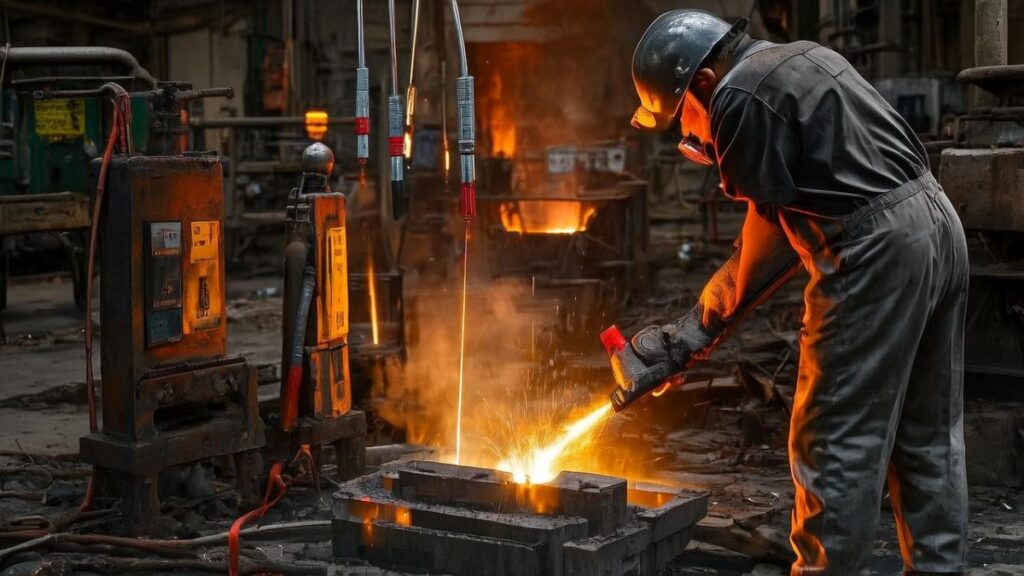What is Casting Heat?
In the world of metalworking, casting heat plays a crucial role in determining the success and quality of a cast metal product. Whether you’re working with aluminum, steel, iron, or any other metal, understanding and controlling casting heat is essential for achieving strong, durable, and precisely shaped components.
But what exactly is casting heat , and why does it matter so much in the foundry and manufacturing industries? In simple terms, casting heat refers to the temperature at which a metal is poured into a mold during the casting process. This temperature must be carefully controlled to ensure that the molten metal flows properly, fills the mold completely, and solidifies correctly without defects.
Too low a casting heat , and the metal might solidify too quickly, leading to incomplete filling and weak spots. Too high a casting heat , and the metal could cause mold erosion, porosity, or thermal stress in the final part. Therefore, finding the optimal casting heat is a science as much as an art.
In this article, we’ll explore everything you need to know about casting heat , including how it affects different metals, how to measure and control it, and best practices used by professionals in the field.
Why Casting Heat Matters in Metal Casting
The casting heat directly influences the microstructure, mechanical properties, and surface finish of the final casting. Here are some key reasons why casting heat is so important:
- Proper Flowability : At the right casting heat , molten metal remains fluid enough to fill intricate mold cavities.
- Minimizing Defects : Controlling casting heat helps prevent issues like cold shuts, shrinkage cavities, and gas porosity.
- Mold Integrity : Excessive casting heat can damage molds or cores, reducing their lifespan and increasing costs.
- Solidification Behavior : The casting heat determines how the metal solidifies, affecting grain structure and internal stresses.
- Energy Efficiency : Maintaining the correct casting heat reduces energy consumption and improves overall efficiency.
To better understand the impact of casting heat , let’s take a look at how different metals behave under various temperatures.
Common Metals and Their Ideal Casting Heat Ranges
Each type of metal has a specific casting heat range that ensures optimal flow, minimal defects, and proper solidification. Below is a table showing typical casting heat values for commonly used metals in industrial casting:
This table highlights how casting heats varies significantly between materials. For instance, magnesium alloys have a relatively low casting heats , but they require special handling due to their flammability. On the other hand, steel needs extremely high casting heats , which demands more advanced equipment and safety precautions.
How Casting Heat Affects Different Casting Processes
There are several types of casting methods, each requiring precise control over casting heats . Let’s examine how casting heats influences these processes:
Sand Casting
Sand casting is one of the oldest and most widely used methods. It involves creating a mold from compacted sand and pouring molten metal into it. Because sand molds are porous, the casting heats must be high!
However, excessive casting heats can cause the sand to fuse, damaging the mold and causing surface imperfections. Therefore, maintaining the ideal casting heat is critical to achieving good dimensional accuracy and surface finish.
Investment Casting
Also known as lost-wax casting, investment casting produces highly detailed and complex parts. The wax pattern is coated with ceramic layers to form the mold. Since ceramic molds are less permeable than sand, the casting heats must be slightly higher to ensure complete mold filling.
Moreover, because investment casting is often used for aerospace and medical components, strict control over casting heats is necessary to meet stringent quality standards.
Die Casting
Die casting uses reusable metal molds and high-pressure injection of molten metal. Due to the rapid cooling rate of metal dies, the casting heats must be carefully managed to avoid premature solid!
For example, in hot-chamber die casting, where the injection system is submerged in molten metal, the casting heats is automatically maintained within a safe range. However, in cold-chamber die casting, the operator must manually adjust the casting heats based on alloy type and part geometry.
Centrifugal Casting
Used primarily for cylindrical parts like pipes and rings, centrifugal casting relies on rotational force to distribute the molten metal evenly. The casting heat here must be sufficient to maintain fluidity long enough for the metal to reach all areas of the mold before solidifying.
If the casting heat drops too quickly, segregation of elements may occur, leading to uneven material properties in the final casting.
Tools and Techniques to Measure and Control Casting Heat
Accurate measurement and control of casting heats are vital for consistent casting quality. Here are some common tools and techniques used in the industry:
Pyrometers
Pyrometers are non-contact devices that measure the surface temperature of molten metal using infrared radiation. They are quick and easy to use, making them popular in fast-paced production environments.
Thermocouples
Thermocouples are inserted directly into the molten metal stream to provide real-time temperature readings. While more accurate than pyrometers, they require careful calibration and maintenance.
Optical Sensors
Advanced foundries use optical sensors that analyze the color and intensity of the molten metal to estimate its temperature. These systems are integrated into automated casting lines for continuous monitoring.
Temperature-Controlled Furnaces
Modern induction furnaces come equipped with digital controls that allow operators to set and maintain precise casting heats levels. Some models even feature automatic shut-off when the desired temperature is reached.
Preheating Molds
Preheating the mold before pouring helps maintain the casting heats of the molten metal for longer. This practice also reduces thermal shock and extends mold life.
Best Practices for Managing Casting Heat
Managing casting heats effectively requires a combination of technical knowledge, experience, and attention to detail. Here are some best practices recommended by experts:
- Know Your Alloy : Each metal and alloy has unique thermal properties. Always refer to manufacturer guidelines for recommended casting heats ranges.
- Monitor Consistently : Use calibrated instruments to check casting heats regularly throughout the day.
- **Adjust for Ambient Conditions!
- Maintain Equipment : Regularly inspect and calibrate pyrometers, thermocouples, and furnace controls to ensure accuracy.
- Train Operators : Proper training ensures that all personnel understand the importance of casting heats and how to manage it safely.
- Record Data : Keeping logs of casting heats and corresponding outcomes helps identify trends and improve future processes.
Troubleshooting Common Casting Heat Issues
Even with careful planning, problems can arise related to improper casting heat . Here are some common issues and how to address them:
By identifying the root cause of these issues, foundry workers can make informed adjustments to the casting heat and improve casting quality.
Conclusion: Mastering Casting Heat Leads to Better Results
In summary, casting heats is a fundamental parameter in metal casting that significantly impacts the integrity, performance, and appearance of the final product. From choosing the right **casting heat!
Whether you’re a hobbyist working in a small workshop or part of a large-scale manufacturing team, understanding and managing casting heat is essential for producing high-quality castings consistently. By following best practices, using the right tools, and staying informed about the properties of your materials, you can master the art and science of casting heats .







